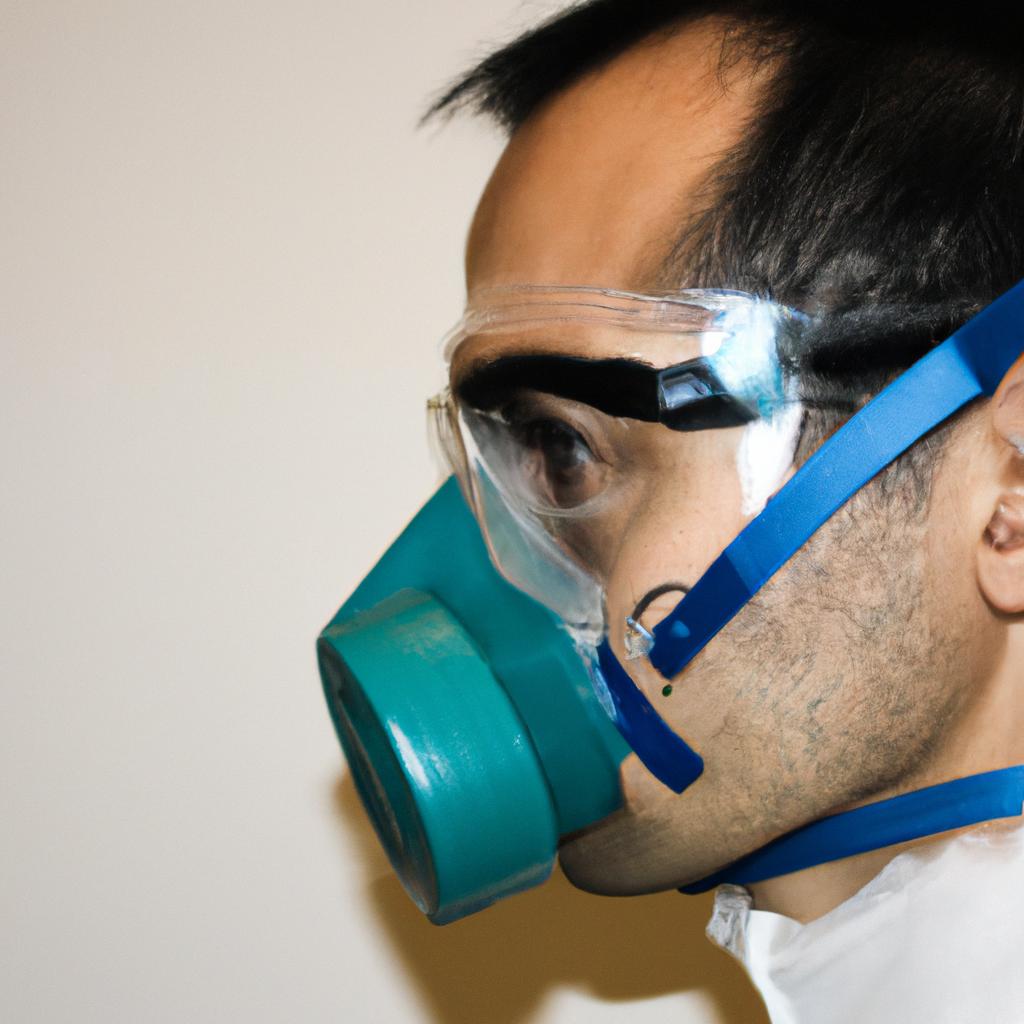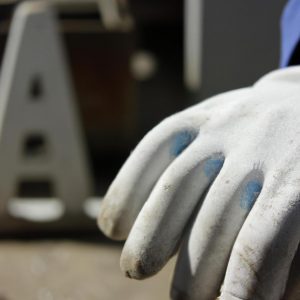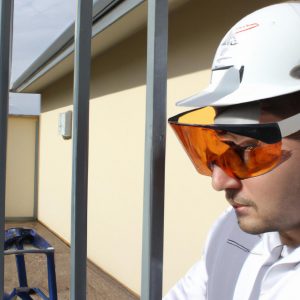Respiratory Protection in Safety Equipment: Ensuring Workplace Safety and Health

Respiratory protection is a critical component of safety equipment that plays a crucial role in ensuring workplace safety and health. By effectively preventing the inhalation of harmful substances, respiratory protection safeguards workers from potential hazards such as toxic chemicals, airborne particles, and infectious agents. For instance, let us consider a hypothetical scenario where an employee working in a chemical plant is exposed to hazardous vapors without proper respiratory protection. In this situation, the individual’s respiratory system would be at risk of serious damage or long-term health complications. Therefore, it becomes imperative for employers to prioritize the implementation of robust respiratory protection programs within their organizations.
In recent years, there has been increasing recognition of the importance of respiratory protection in safeguarding worker well-being. The Occupational Safety and Health Administration (OSHA) emphasizes the need for appropriate respiratory protective equipment (RPE) when exposure to harmful contaminants cannot be eliminated through engineering controls alone. This acknowledgement stems from numerous incidents involving occupational illnesses caused by inadequate respiratory protection measures. These cases highlight the significance of implementing comprehensive strategies that encompass proper selection, fit-testing, training, maintenance, and regular inspection of RPE to ensure optimal effectiveness. As we delve further into this article, we will explore various aspects related to respiratory protection in safety equipment and discuss best practices for its implementation.
One crucial aspect of respiratory protection is the selection of appropriate respirators based on the specific hazards present in the workplace. Different types of respirators, such as air-purifying respirators (APRs) and supplied-air respirators (SARs), are designed to protect against different types of contaminants. It is essential to consider factors such as the concentration and nature of the hazardous substances, as well as any potential oxygen-deficient atmospheres, when selecting the appropriate type of respirator.
Fit-testing is another critical component of respiratory protection programs. A proper fit ensures that the respirator forms a secure seal around the wearer’s face, preventing contaminants from entering through gaps. Fit-testing should be conducted initially upon selection and regularly thereafter to account for any changes in facial structure or equipment wear and tear.
Training plays a vital role in ensuring that employees understand how to properly use, maintain, and inspect their respiratory protection equipment. This training should cover topics such as putting on and removing respirators correctly, conducting user seal checks, replacing filters or cartridges, and recognizing signs of equipment malfunction or degradation.
Maintenance and regular inspection are also crucial to ensure that respiratory protective equipment remains effective over time. Employers should establish procedures for cleaning, disinfecting, storing, and inspecting respirators to identify any damage or deterioration that may compromise their performance.
In conclusion, respiratory protection is an essential component of safety equipment that helps safeguard workers’ health by preventing inhalation exposure to hazardous substances. Implementing comprehensive respiratory protection programs that encompass proper selection, fit-testing, training, maintenance, and regular inspection can significantly reduce occupational illnesses caused by inadequate respiratory protection measures. By prioritizing worker safety through robust respiratory protection strategies, employers can create a healthier work environment for their employees.
Understanding the Importance of Respiratory Protection
In today’s fast-paced world, workplace safety and health have become paramount concerns for employers and employees alike. One area that requires special attention is respiratory protection. Ensuring proper measures are in place to safeguard against respiratory hazards can greatly reduce the risk of occupational illnesses and injuries.
To illustrate this point, let us consider a hypothetical scenario in which an industrial worker is exposed to harmful airborne particles without appropriate respiratory protection. Over time, this individual may develop respiratory conditions such as asthma or chronic obstructive pulmonary disease (COPD), resulting in decreased productivity, increased healthcare costs, and potential long-term disability. This unfortunate situation could have been prevented if effective respiratory protective equipment had been provided.
The importance of respiratory protection extends beyond individual cases; it also has broader implications for overall workplace safety and well-being. Here are some key reasons why investing in adequate respiratory protection is crucial:
- Preventing Inhalation Hazards: Airborne contaminants such as dust, fumes, gases, vapors, and biological agents pose significant risks when inhaled regularly or at high concentrations. Properly selected respirators act as a barrier between these hazardous substances and the wearer’s lungs.
- Minimizing Health Risks: Prolonged exposure to airborne pollutants can lead to a wide range of adverse health effects, including lung diseases, allergies, cancers, and even death. By implementing robust respiratory protection programs, organizations demonstrate their commitment to preserving employee health.
- Compliance with Regulations: Governments worldwide have implemented stringent regulations regarding workplace safety standards. Failure to comply with these requirements can result in legal repercussions and reputational damage for businesses. Incorporating effective respiratory protection protocols helps ensure compliance with regulatory frameworks.
- Promoting Trust and Employee Engagement: Employees who feel safe at work tend to be more engaged and productive. Demonstrating care by providing reliable respiratory protective equipment fosters trust among workers while enhancing morale within the organization.
To better understand the significance of respiratory protection, refer to the following table:
| Hazards | Potential Health Effects | Importance of Respiratory Protection |
|---|---|---|
| Airborne Dust | Irritation, Allergies | Prevents inhalation and related health risks |
| Chemical Vapors | Toxicity, Organ Damage | Minimizes exposure to harmful substances |
| Biological Agents | Infections, Diseases | Reduces risk of contagion and transmission |
| Particulate Matter | Lung damage, Cancer | Ensures safe breathing in polluted environments |
By recognizing the importance of respiratory protection, organizations can take proactive steps towards creating a safer work environment. The subsequent section will delve into various types of respiratory hazards commonly encountered in workplaces and explore effective strategies for mitigating these risks.
Types of Respiratory Hazards in the Workplace
Understanding the Importance of Respiratory Protection is crucial for maintaining a safe and healthy workplace environment. However, it is equally important to recognize the different types of respiratory hazards that can be present in various industries. By being aware of these potential risks, employers can take appropriate measures to protect their workers.
One example highlighting the importance of respiratory protection involves a manufacturing plant where workers were exposed to high levels of airborne contaminants. Without proper respiratory equipment, employees experienced symptoms such as coughing, shortness of breath, and even more serious respiratory illnesses. This case study serves as a reminder that neglecting respiratory protection can have severe consequences on both individual health and overall productivity.
To further emphasize this point, here are some key factors regarding the significance of respiratory protection:
- Exposure to hazardous substances: Many industrial processes involve working with chemicals or other harmful substances that release dangerous particles into the air.
- Airborne diseases: Certain workplaces may expose individuals to infectious agents or pathogens that can spread through inhalation.
- Dust and particulate matter: Industries like construction and mining produce fine dust particles that pose significant health risks if inhaled regularly.
- Occupational lung diseases: Prolonged exposure to certain substances without adequate protection can lead to chronic conditions such as asthma, pneumoconiosis, or occupational bronchitis.
| Respiratory Hazards | Potential Health Risks |
|---|---|
| Chemical fumes | Lung damage |
| Asbestos fibers | Mesothelioma |
| Silica dust | Silicosis |
| Biological agents | Infectious diseases |
By understanding these hazards and their associated health risks, employers can implement effective control measures to safeguard their workforce against potential harm. Providing suitable respiratory protection not only protects employee well-being but also boosts morale by demonstrating an employer’s commitment towards ensuring workplace safety.
Transitioning into the subsequent section about “Key Factors for Selecting the Right Respiratory Protection,” it is essential to consider various aspects before choosing the appropriate equipment. Safeguarding workers from respiratory hazards requires a thoughtful approach that encompasses factors such as risk assessment, workplace conditions, and regulatory compliance.
Key Factors for Selecting the Right Respiratory Protection
Respiratory hazards in the workplace can present serious risks to employee health and safety. One example is exposure to airborne particulates, such as dust or fibers, which can lead to respiratory illnesses like pneumoconiosis. In a recent case study conducted at a construction site, workers were exposed to high levels of silica dust due to inadequate respiratory protection measures. This resulted in several employees developing silicosis, highlighting the importance of implementing proper respiratory protection.
To effectively select the right respiratory protection for employees, it is crucial to consider key factors that ensure optimal safety and effectiveness. These factors include:
-
Hazard Identification: Before choosing any protective equipment, employers must conduct thorough hazard assessments specific to their work environment. This involves identifying potential respiratory hazards and evaluating their severity and frequency. By understanding these hazards, employers can determine the appropriate level of protection required for their workforce.
-
Respirator Selection: Once hazards are identified, selecting the most suitable respirator becomes paramount. There are various types available on the market, including disposable masks, half-facepiece respirators with replaceable filters, full-facepiece respirators with cartridges, powered air-purifying respirators (PAPRs), and self-contained breathing apparatuses (SCBAs). Each type offers different levels of protection based on filtration efficiency and compatibility with other personal protective equipment (PPE).
-
Fit Testing: Proper fit testing ensures that selected respirators provide an adequate seal around an individual’s face while minimizing leakage from outside contaminants. Fit testing should be conducted before initial use as well as periodically thereafter to account for changes in facial characteristics or weight fluctuations among employees.
-
Training and Maintenance: Providing comprehensive training on how to correctly wear, remove, store, and maintain respiratory equipment is essential for ensuring its long-term effectiveness. Employees should also be educated about signs of deterioration or malfunctioning so they can promptly report any issues to the appropriate personnel.
| Factors | Considerations |
|---|---|
| Hazard Identification | Identify respiratory hazards through assessments |
| Respirator Selection | Choose suitable respirators based on filtration efficiency and compatibility with PPE |
| Fit Testing | Conduct fit testing before initial use and periodically thereafter |
| Training and Maintenance | Provide comprehensive training and regular maintenance for optimal effectiveness |
By thoroughly considering these key factors, employers can make informed decisions when selecting respiratory protection for their workforce. In doing so, they ensure that employees are adequately protected against workplace respiratory hazards.
Transition into subsequent section: Now let’s explore another vital aspect of ensuring employee safety—proper fit testing and training for respiratory equipment.
Proper Fit Testing and Training for Respiratory Equipment
Having discussed the key factors for selecting the right respiratory protection in the previous section, it is crucial to now shift our focus towards proper fit testing and training for respiratory equipment. This section aims to highlight the importance of ensuring a secure fit and providing adequate training to ensure optimal effectiveness.
Fit testing is an essential step in guaranteeing that respiratory protective equipment (RPE) fits properly and offers maximum protection against hazardous substances. For instance, consider a hypothetical scenario where workers at a chemical plant are provided with respirators without proper fit testing. In such cases, if the respirators do not create an effective seal around their faces, harmful contaminants could easily enter their respiratory systems, leading to severe health consequences.
To ensure that RPE provides a snug and secure fit, several factors must be considered:
- Facial characteristics: Different individuals have varying facial features that can affect how well a mask fits. It is important to select masks or respirators that cater to different face shapes and sizes.
- User comfort: Comfort plays a significant role in encouraging compliance among workers. Uncomfortable masks may lead employees to adjust or remove them during work hours, compromising their safety.
- Occupational hazards: Identifying specific workplace hazards will help determine which type of RPE is most suitable. Some situations may require specialized equipment like powered air-purifying respirators (PAPRs) or self-contained breathing apparatus (SCBA).
- Periodic reassessment: Fit testing should not be seen as a one-time activity but rather as an ongoing process. Regular reassessment ensures that changes in physical appearance or occupational conditions are accounted for.
| Type of Respiratory Equipment | Advantages | Disadvantages |
|---|---|---|
| Disposable N95 Masks | Lightweight and cost-effective | Limited reuse potential |
| Half-Facepiece Respirators | Offers good visibility | Less protection compared to full-face |
| Full-Facepiece Respirators | Provides enhanced protection | Can be heavy and bulky |
| Powered Air-Purifying Respirator | Increased comfort and flexibility | Requires a power source |
In conclusion, fit testing is a critical component of respiratory protection. By considering various factors such as facial characteristics, user comfort, occupational hazards, and periodic reassessment, employers can ensure that their workers are adequately protected from harmful substances in the workplace.
Moving forward, it is equally important to discuss the maintenance and inspection of respiratory protection equipment to maintain its effectiveness and prolong its lifespan.
Maintenance and Inspection of Respiratory Protection
Having established the importance of proper fit testing and training for respiratory equipment, it is equally imperative to address the significance of maintenance and regular inspection. Failure to adequately maintain and inspect respiratory protection can compromise its effectiveness, potentially leading to severe consequences. To illustrate this point, consider a hypothetical scenario where an employee working in a hazardous environment fails to properly inspect their respirator before use. Due to this oversight, the respirator malfunctions while they are exposed to harmful airborne particles, resulting in serious respiratory illness.
Maintenance and inspection play vital roles in ensuring that respiratory protection remains reliable and functional throughout its lifespan. By following recommended guidelines set forth by regulatory bodies such as OSHA (Occupational Safety and Health Administration), organizations can minimize risks associated with faulty or inadequate equipment. The following bullet points outline key aspects of maintenance and inspection procedures that should be implemented:
- Regular cleaning of respirators using manufacturer-approved methods
- Replacement of worn-out parts or components as per manufacturer’s instructions
- Storage practices that prevent damage or contamination
- Periodic calibration checks for devices with electronic monitoring systems
It is crucial for employers to establish a comprehensive program that incorporates routine inspections at predetermined intervals. These inspections should encompass visual assessments, checking seals and valves for degradation, assessing strap integrity, evaluating filters’ condition, and ensuring overall functionality. A well-maintained inventory system should also be maintained, documenting each device’s service history along with any repairs or replacements performed.
Incorporating emotional appeal into our discussion further strengthens the case for meticulous maintenance and inspection protocols. Consider the following table showcasing potential hazards arising from neglecting these essential processes:
| Neglected Process | Potential Hazards |
|---|---|
| Inadequate Cleaning | Accumulation of contaminants leading to compromised filtration efficiency |
| Ignoring Parts Replacement Recommendations | Increased likelihood of equipment failure during critical moments |
| Improper Storage | Damage to the equipment due to exposure to environmental elements |
| Neglecting Calibration Checks | Inaccurate readings or malfunction of electronic monitoring systems |
By acknowledging these potential hazards and their consequences, employers can foster a safer working environment that prioritizes employee well-being.
To ensure the effectiveness of respiratory protection programs, evaluating various aspects becomes imperative. The subsequent section will delve into methods employed for assessing program efficacy and determining areas for improvement without compromising worker safety.
Evaluating the Effectiveness of Respiratory Protection Programs
Transitioning from the previous section on maintenance and inspection, it is crucial to evaluate the effectiveness of respiratory protection programs to ensure their reliability in safeguarding workplace safety and health. To illustrate this point, consider a hypothetical scenario where an industrial facility implemented a comprehensive respiratory protection program but experienced a sudden increase in respiratory-related illnesses among its employees. This situation highlights the importance of ongoing evaluation to identify potential gaps or shortcomings within such programs.
To effectively assess the impact of respiratory protection programs, several key factors should be considered:
-
Compliance Monitoring: Regular monitoring ensures that employees are adhering to established protocols for wearing personal protective equipment (PPE) consistently. By conducting periodic checks and audits, employers can identify any deviations from best practices and take corrective measures promptly.
-
Fit Testing: Proper fit testing helps determine whether respirators provide adequate protection against airborne contaminants. It involves assessing how well the respirator forms a seal around an individual’s face through various techniques such as qualitative or quantitative fit tests. Regular reassessment is vital since changes in weight, facial hair, or other physical attributes may affect the respirator’s efficacy over time.
-
Training Effectiveness: Comprehensive training sessions educate employees about proper use, storage, and maintenance of respiratory protective equipment. Periodic evaluations can gauge employees’ understanding and proficiency by incorporating practical exercises to simulate real-life scenarios.
-
Incident Analysis: Analyzing incidents related to respiratory hazards provides valuable insights into program effectiveness. Identifying patterns or trends enables proactive interventions aimed at reducing risks associated with specific work processes or environmental conditions.
The following table illustrates the emotional significance of evaluating respiratory protection programs for both employers and employees:
| Employer Perspective | Employee Perspective | Overall Impact |
|---|---|---|
| Enhanced reputation | Increased confidence | Improved workplace morale |
| Reduced liability | Lowered health risks | Enhanced productivity |
| Compliance with regulations | Improved job satisfaction | Cultivation of safety culture |
| Cost savings | Personal well-being preservation | Prevention of respiratory illnesses |
In conclusion, evaluating the effectiveness of respiratory protection programs is crucial in maintaining workplace safety and health. By considering factors such as compliance monitoring, fit testing, training effectiveness, and incident analysis, employers can identify areas for improvement and ensure that employees are adequately protected from respiratory hazards. Such evaluations benefit both employers and employees by fostering a safer work environment, boosting morale, reducing liabilities, and ultimately enhancing overall productivity.
Note: The next section should follow H2 format without using ‘now’.



